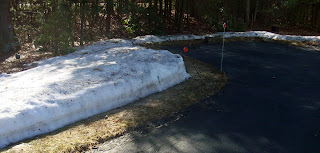 |
| The Hellebores outside the front door |
Winter is finally in full retreat in eastern Massachusetts. Most homes in my town have long since seen their mounds of snow melt. Because so much snow needs to be removed from the top of my driveway, there is still a swatch of snow (ice, really) that is more than a foot high in spots. Each year at the beginning of March, Betty and I make a bet as to when the last ice will melt. This year, I guessed April 10; Betty took April 15. With eleven days to go until my deadline, it is touch and go as to who is going to win.
| How deep was the snow this winter? Compare the lamp post in the two photos. |
But the melting snow yielded its share of bad news. The snow mound in the inner sidewalk bed – the site of those Hellebores – hid the fact that our oxydendrum had taken a major hit, losing seven lower branches. Planted three years ago, we had chosen that particular sourwood for its perfect shape. Now, with a third of its apparently delicate branches shorn by ice and snow, the tree is top-heavy. No, we won’t yank it out, but recovery will likely take years and, in future winters, we will likely construct a barrier around it as we do the nearby thuja occidentalis.
Another casualty is the Chamaecyparis ‘Sungold’, a ground-hugging so-called ‘false cypress’ that is – or perhaps was – a key part of the ‘structural elements’ Betty has been adding to the outer sidewalk bed. Many New Englanders simply abandon their front doors for the winter and don’t bother to shovel out their sidewalks, making their garages the de jure entrances as well as the de facto one. While we would no more park our car in our garage and then walk back outside to use the front door than we would drink tea with our pinkies extended, we maintain a quaint notion that guests should not have to inspect the detritus in our garage as a precondition of entering our home. And so we shovel the sidewalk down to bare concrete after every storm, no matter how inconsequential.
 |
| Chamaecyparis 'Sungold' - or its remains. Time will tell if it is salvageable. |
Much of our garden remains to be uncovered. A thick blanket of oak leaves covers the rock gardens and those leaves are removed delicately so as not to injure the plants underneath. I don’t expect a lot of surprises there; killing stonecrop is next to impossible and our extensive hosta garden seems to thrive after a vicious winter. (One exception: the carefully placed markers identifying the hostas have a disturbing habit of disappearing every winter. We suspect raccoons.) Elsewhere, the customary number of pines are down and a birch bordering the driveway lost its top. The town plow ‘relocated’ several plants in our xeric garden and these have been restored to their proper sites. These are the expected casualties of winter.
I keep reminding myself that the long New England winter and ugly early spring have the effect of making the later spring and summer here all the more beautiful and precious. I’m going to make a point of enjoying the blooms on those Hellebores every day… even if it means I have to use the front door.
 |
| The snow mound in retreat on the last day of March. I say it will be gone on April 10, Betty says April 15. We'll see who is right. |











